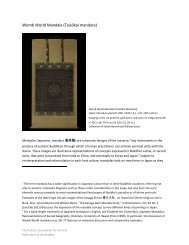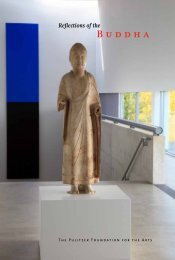Four-circle Hevajra Mandala - Reflections of the Buddha
Four-circle Hevajra Mandala - Reflections of the Buddha
Four-circle Hevajra Mandala - Reflections of the Buddha
Create successful ePaper yourself
Turn your PDF publications into a flip-book with our unique Google optimized e-Paper software.
<strong>Four</strong>-<strong>circle</strong> <strong>Hevajra</strong> <strong>Mandala</strong> 4<br />
<strong>the</strong> red <strong>of</strong> <strong>the</strong> south. 10 The directionality <strong>of</strong> <strong>the</strong> color scheme employed in a thangka may give some<br />
indication <strong>of</strong> how it was originally hung in a monastic space. 11<br />
Within <strong>the</strong> gates lies a narrow red band running along <strong>the</strong> four sides <strong>of</strong> <strong>the</strong> palace, on which are<br />
depicted tiny, seated figures, whom I have yet to identify. This narrow band is followed by a much<br />
broader, foliated band, colored again in accordance with <strong>the</strong> four directions. On this band may be found<br />
eight dakinīs (also called, more generically, yoginīs—that is female practitioners <strong>of</strong> yoga), female<br />
attendants to <strong>Hevajra</strong>, who dance atop corpses lying upon red lotuses. These female deities are all<br />
specifically named and described in <strong>the</strong> <strong>Hevajra</strong>-tantra. 12 Interspersed among <strong>the</strong>m are vases, common<br />
accoutrements to consecratory rituals. Finally, at <strong>the</strong> center <strong>of</strong> <strong>the</strong> palace, <strong>the</strong> manifestation <strong>of</strong> <strong>Hevajra</strong><br />
himself stands atop a lotus pedestal, again rendered from a top-down view, thus indicating <strong>the</strong> deity’s<br />
occupying <strong>the</strong> highest point <strong>of</strong> this generally pyramidal mandala. Each manifestation <strong>of</strong> <strong>Hevajra</strong> is<br />
depicted in <strong>the</strong> ardha-paryaṅka pose, dancing atop one or more corpses. The four legs <strong>of</strong> <strong>the</strong> sixteenarmed<br />
Hrdaya-<strong>Hevajra</strong>, for example, trample four corpses, understood to signify <strong>the</strong> four Māras, or<br />
demonic obstructions, to one’s progress on <strong>the</strong> <strong>Buddha</strong>’s path. 13<br />
10 For <strong>the</strong> correlation between colors and directions in <strong>Hevajra</strong> mandalas, see Zhu, “<strong>Hevajra</strong> Tantra,” in Huntington<br />
and Bangdel, pp. 454-456, and Catalog Entry #143, “<strong>Hevajra</strong> <strong>Mandala</strong>,” in ibid., pp. 461-464. This correlation is<br />
somewhat different from <strong>the</strong> more common system based on <strong>the</strong> Five Wisdom (or Jina) <strong>Buddha</strong>s <strong>of</strong> <strong>the</strong> Vajradhātu<br />
(Diamond World), each <strong>of</strong> whom symbolizes a particular aspect <strong>of</strong> enlightenment. This system identifies red with<br />
Amitābha, <strong>the</strong> <strong>Buddha</strong> <strong>of</strong> <strong>the</strong> West; green with Amoghasiddhi, <strong>Buddha</strong> <strong>of</strong> <strong>the</strong> North; blue with Aksobhya, <strong>Buddha</strong><br />
<strong>of</strong> <strong>the</strong> East; yellow with Ratnasambhava, <strong>Buddha</strong> <strong>of</strong> <strong>the</strong> South; and white with Vairocana, <strong>the</strong> Cosmic <strong>Buddha</strong> <strong>of</strong><br />
<strong>the</strong> Center. For more on this system, see Amy M. Livingston, “Goal <strong>of</strong> <strong>the</strong> Transformed Mind: Enlightenment<br />
Symbolized,” in ibid., pp. 90-92. <strong>Mandala</strong>s based on o<strong>the</strong>r tantras make use <strong>of</strong> yet o<strong>the</strong>r correlative systems;<br />
Kalachakra mandalas, for example, identify blue with east, red with south, yellow with west, white with north, and<br />
green with <strong>the</strong> center. See Rebecca L. Twist and Dina Bangdel, “Kalachakra Tantra,” in ibid., pp. 475-479, esp. 478.<br />
Although <strong>the</strong> directional correlations vary depending on <strong>the</strong> text, <strong>the</strong> five basic colors remain <strong>the</strong> same. These<br />
principal colors have been grouped toge<strong>the</strong>r since <strong>the</strong> earliest days <strong>of</strong> Buddhism and are mentioned in <strong>the</strong> Dīrgha<br />
Āgama (Chinese, Chang Ahan jing 長 阿 含 經 ), a collection <strong>of</strong> early Theravada texts translated into Chinese in 413.<br />
For background information on <strong>the</strong> Five Colors (Sanskrit, pañca-varnā), see “ゴシキ| 五 色 ” in Mochizuki Shinkō 望<br />
月 信 亨 , Bukkyō daijiten 佛 教 大 辞 典 , vol. 2 (Tokyo: Bukkyō daijiten hakkōjo, 1931-1963), 1189-1190. At least one<br />
scholar has suggested that because <strong>of</strong> <strong>the</strong>ir vibrancy, ancient Indian religious practitioners were prohibited from<br />
using <strong>the</strong>se five colors for <strong>the</strong>ir robes. See “ 五 色 ” in Nakamura Hajime 中 村 元 , Bukkyōgo daijiten 佛 教 語 大 辞 典 ,<br />
vol. 1 (Tokyo: Tōkyō shoseki, 1975), 363.<br />
11 Directionality is perhaps most clearly embedded in <strong>the</strong> Diamond and Womb World <strong>Mandala</strong>s (Japanese:<br />
Kongōkai mandara 金 剛 界 曼 荼 羅 and Taizōkai mandara 胎 蔵 界 曼 荼 羅 ) employed in Japanese Shingon 真 言 and<br />
Tendai 天 台 Buddhism. The mandalas are hung facing each o<strong>the</strong>r, with <strong>the</strong> Diamond World on <strong>the</strong> western wall<br />
and <strong>the</strong> Womb World on <strong>the</strong> eastern wall. All <strong>of</strong> <strong>the</strong> deities in <strong>the</strong>se mandalas, many <strong>of</strong> whom are associated with<br />
a particular direction, are placed in accordance with <strong>the</strong> directional scheme implied by <strong>the</strong> hanging <strong>of</strong> <strong>the</strong><br />
mandalas. Thus, in <strong>the</strong> Diamond World <strong>Mandala</strong>, Amitābha, <strong>the</strong> <strong>Buddha</strong> <strong>of</strong> <strong>the</strong> West, is always depicted at <strong>the</strong> top<br />
(i.e., west) <strong>of</strong> a group <strong>of</strong> deities, while in <strong>the</strong> Womb World <strong>Mandala</strong>, he is always depicted at bottom. For an<br />
introduction to <strong>the</strong>se mandalas, see Elizabeth ten Grotenhuis, Japanese <strong>Mandala</strong>s: Representations <strong>of</strong> Sacred<br />
Geography (Honolulu: University <strong>of</strong> Hawai’i Press, 1999), pp. 33-95.<br />
12 See Snellgrove, The <strong>Hevajra</strong> Tantra, vol. 1, pp. 111-112. A convenient chart may also be found in Zhu, “<strong>Hevajra</strong><br />
Tantra,” in Huntington and Bangdel, p. 456.<br />
13 Zhu, “<strong>Hevajra</strong> Tantra,” in Huntington and Bangdel, p. 455.<br />
The Pulitzer Foundation for <strong>the</strong> Arts<br />
<strong>Reflections</strong> <strong>of</strong> <strong>the</strong> <strong>Buddha</strong>




